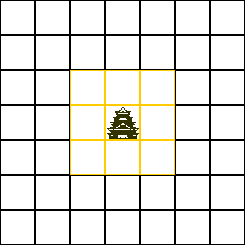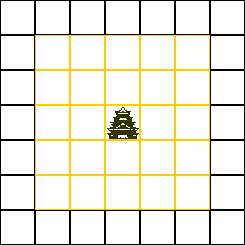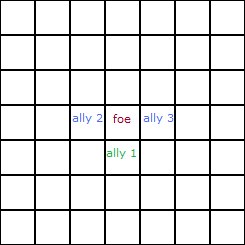Each army normally speaking has 10 turns, though this default may be increased if the general has a bonus from his logistics trait. That means an army can move 10 grids in a single year. Armies may move horizontally and vertically on the map, but not diagonally.
You cannot move your army to a grid occupied by another army. So if wish to conquer a town, that is occupied by an enemy army, you must first eliminate that enemy army.
You must first select one of your armies, if you wish to move it. You can move your army using the arrow keys on the numpad.
Armies can move accross water, or else it would be impossible to hop from island to island. When an army is moving over a sea or a lake, it becomes a navy.
Navies do not receive any bonuses from terrain and weather, except that units who wield a teppou, yumi or katana get an extra hitpoint. The units do maintain the bonuses from the personality of the clan. So clans with the wokou personality have an advantage on water.
An attack takes up 3 movement turns. You can attack an enemy army with your army by positioning your army adjacent to the enemy army, either horizontally or vertically.
A conquest of a town takes up 3 movement turns. You can conquer a region by placing your army on top of an enemy grid with a town that has a castle or a temple of whatever level. The area that you conquer is the grid with the town containing the castle or temple, and the grids directly adjacent to that grid, whether that is horizontally, vertically, or diagonally (excluding grids which also contain towns with temples or castles). See the picture below for greater detail.

Pillaging takes up 2 movement points. A pillage destroys all the buildings and fields in that district. Whoever pillages a district receives a small portion of koku as plunder. If you pillage a castle or temple, then all the surrounding districts are also destroyed (excluding grids which also contain towns with temples or castles).
Your towns, villages, armies and covert units have a line of sight of all adjacent grids within a 2 grid radius. See the picture below for greater detail. Anything out of the line of sight, is in the fog of war. Anything inside the fog of war is not visible on the map, that includes armies, castles and temples.
Covert units of other clans are invisible, no matter whether they are in or out of the fog of war. The armies of your liege, vassal and allies are visible on the map.

Terrain may alter the default hitpoints value of a unit. The following table shows how certain terrains alter the default value.
| Unit Type | Swamp | Plains | Forest | Hills | Mountains |
|---|---|---|---|---|---|
| foot | 0 | 0 | 0 | 0 | 0 |
| mounted | -1 | +2 | -1 | -2 | -2 |
| ranged | 0 | +1 | -1 | 0 | 0 |
| melee | 0 | 0 | 0 | 0 | 0 |
| shock | +1 | 0 | +1 | +1 | +1 |
Note that beaches act similar to plains. For plains it does not matter whether this is rice or wheat.
Some districts also have rivers running through them. The defender gets 2 extra hitpoints for each of his or her units where there are rivers or mountains.
Both the defender and the attacker may ambush his or her opponent in a forest. An ambush causes increased casualties to the army being ambushed. Ambushes may also sometimes occur when there is rain or snow. The chances of an ambush to succeed, depend upon the relative size of the army and the bonus received from the tactics trait of the general attached to the army. If the army is relatively small compared to the enemy army, and if the general has a high tactics bonus, then an ambush is more likely to succeed.
Both the defender and the attacker may charge on his or her opponent on plains. A charge causes increased casualties to the army being hit by the charge. The chances of a charge to occur, depend on the relative size of the mounted units in an army and the bonus received from the tactics trait of the general attached to the army.
Charges and ambushes randomly increase casualties by 5 to 30 percent.
Castles may increase the hitpoints of the units of the defending army.
| Castle | Defense |
|---|---|
| Watchtower | 0 |
| Keep | +2 |
| Castle | +4 |
| Fortress | +6 |
Ranged units are negatively affected by rain and snow. They get 1 less hitpoint during rain or snow.
The odds of rain or snow to occur are influenced by the climate of that grid.
Casualties & Victory Condition
The total hitpoints of each army are compared in a fight, to determine the casualties. If the number of total hitpoints of the attacker is higher than the defender, then the attacker has the stronger army in the battle, else the defender has the stronger army in the battle.
The weakest army often gets the highest relative casualties.
Here is how you calculate the default relative casualties of the weaker army:
LC = (1 - (THL / (THL + THW))) * (1 - (THL / (THL + THW)))
Here is how you calculate the default relative casualties of the stronger army:
if LC is lower than 0.5
WC = LC / 2
if LC is between 0.5 and 0.7
WC = LC * LC
if LC is higher or equal than 0.7
WC = (1 - LC) * (1 - LC)
Where:
THL = total hitpoints of the weaker army
THW = total hitpoints of the stronger army
LC = relative casualties of the weaker army
WC = relative casualties of the stronger army
You also get relative casualties of any possible ambush or charge on top of the default casualties. For example: suppose the weaker army gets an extra 30 percent casualties, because of an ambush, and the default casualties were 50 percent, then the total casualties are 80 percent. Keep in mind that a stronger army may also get ambushed, thus it is possible for a stronger army to lose a battle.
Casualties are calculated per type of unit and they are rounded. For example: suppose you have 1 yari ashigaru in your army and you have 50 percent casualties or higher, then you lose that 1 yari ashigaru.
There is one exception to these casualties. If the victorious army is at least 5 times stronger, then the calculation is as follows:
WC = 1 - LC
The army that gets the highest relative total casualties loses the battle. The battle is undecisive, if relative casualties of both armies are equal. An undecisive battle is resolved in favor of the defender.
Armies that have no more units are considered eliminated. The general of such an army is killed, either due to seppuku (ritual suicide) or from wounds received in battle.
It is possible to make a combined attack of two or three armies on a single enemy army. This second or third army must be occupying the adjacent grid to the left or right of the enemy army in comparison to the army that instigated the combined attack (see picture for greater detail, ally 1 is the army who instigates the attack in this example). Each of the two or three attacking armies do still lose 3 movement points. So it is not possible to join in a combined attack, if the second or third army has not enough movement points left. The armies who join in the combined attack have to be your own army, or armies of your liege, vassal or ally. The advantage of a combined attack is reduced casualties for all of the attacking armies. The chances of a combined attack to occur, depend on the leadership trait of the general whose army instigates the attack.
